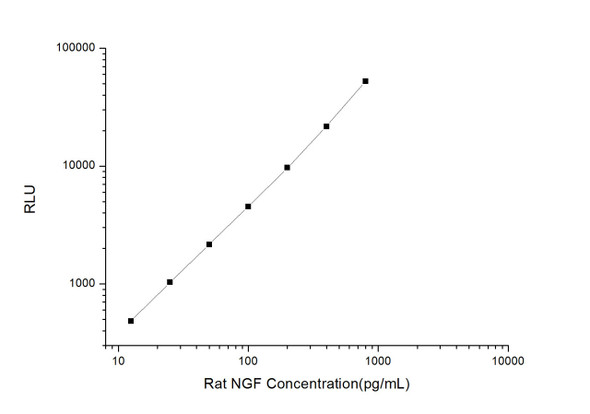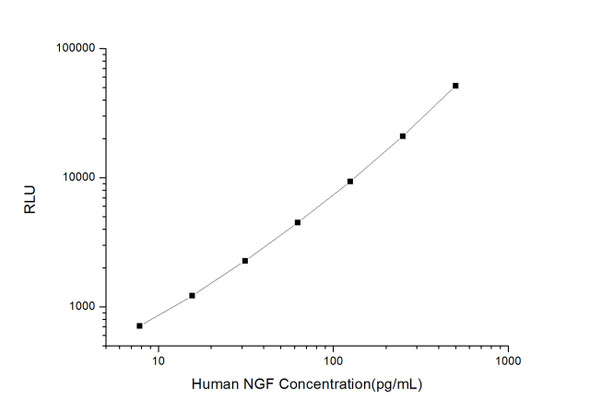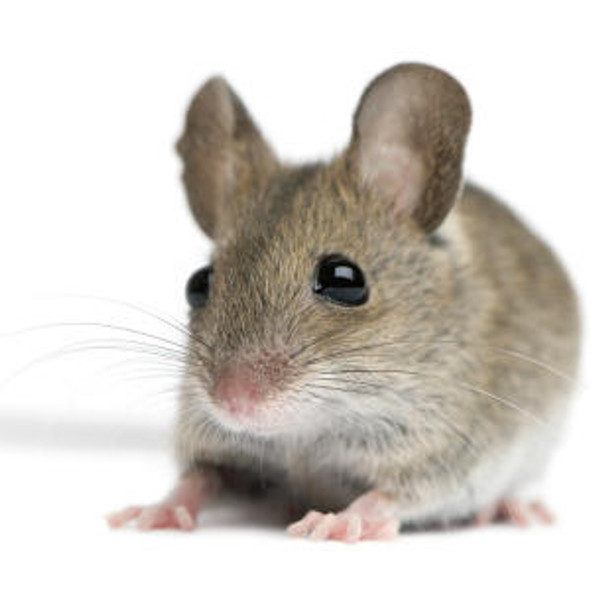Mouse Cell Signalling ELISA Kits 2
Mouse NGF (Nerve growth factor) CLIA Kit (MOES00446)
- SKU:
- MOES00446
- Product Type:
- ELISA Kit
- ELISA Type:
- CLIA Kit
- Size:
- 96 Assays
- Sensitivity:
- 7.5pg/mL
- Range:
- 12.5-800pg/mL
- ELISA Type:
- Sandwich
- Synonyms:
- Beta-NGF, HSAN5, NGFB, NGF-B
- Reactivity:
- Mouse
- Sample Type:
- Serum, plasma and other biological fluids
Description
| Assay type: | Sandwich |
| Format: | 96T |
| Assay time: | 4.5h |
| Reactivity: | Mouse |
| Detection method: | Chemiluminescence |
| Detection range: | 12.50-800 pg/mL |
| Sensitivity: | 7.50 pg/mL |
| Sample volume: | 100µL |
| Sample type: | Serum, plasma and other biological fluids |
| Repeatability: | CV < 15% |
| Specificity: | This kit recognizes Mouse NGF in samples. No significant cross-reactivity or interference between Mouse NGF and analogues was observed. |
This kit uses Sandwich-CLIA as the method. The micro CLIA plate provided in this kit has been pre-coated with an antibody specific to Mouse NGF. Standards or samples are added to the appropriate micro CLIA plate wells and combined with the specific antibody. Then a biotinylated detection antibody specific for Mouse NGF and Avidin-Horseradish Peroxidase (HRP) conjugate are added to each micro plate well successively and incubated. Free components are washed away. The substrate solution is added to each well. Only those wells that contain Mouse NGF, biotinylated detection antibody and Avidin-HRP conjugate will appear fluorescence. The Relative light unit (RLU) value is measured spectrophotometrically by the Chemiluminescence immunoassay analyzer. The RLU value is positively associated with the concentration of Mouse NGF. The concentration of Mouse NGF in the samples can be calculated by comparing the RLU of the samples to the standard curve.
| UniProt Protein Function: | NGF: Nerve growth factor is important for the development and maintenance of the sympathetic and sensory nervous systems. Extracellular ligand for the NTRK1 and NGFR receptors, activates cellular signaling cascades through those receptor tyrosine kinase to regulate neuronal proliferation, differentiation and survival. Homodimer. Belongs to the NGF-beta family. |
| UniProt Protein Details: | Protein type:Secreted, signal peptide; Secreted Cellular Component: extracellular space; cytoplasmic membrane-bound vesicle; extracellular region Molecular Function:metalloendopeptidase inhibitor activity; nerve growth factor receptor binding; growth factor activity; receptor signaling protein activity; receptor binding Biological Process: positive regulation of neuron maturation; regulation of neuron differentiation; adult locomotory behavior; positive regulation of axon extension; regulation of neurotransmitter secretion; sensory perception of pain; positive regulation of cell growth; positive regulation of protein amino acid autophosphorylation; positive regulation of nerve growth factor receptor signaling pathway; memory; regulation of release of sequestered calcium ion into cytosol; peripheral nervous system development; neuron apoptosis; induction of apoptosis via death domain receptors; positive regulation of cell proliferation; positive regulation of transcription factor activity; negative regulation of neuron apoptosis; positive regulation of neuron differentiation; positive regulation of collateral sprouting; transmembrane receptor protein tyrosine kinase signaling pathway; neurite morphogenesis; neurite development |
| UniProt Code: | P01139 |
| NCBI GenInfo Identifier: | 128162 |
| NCBI Gene ID: | 18049 |
| NCBI Accession: | P01139. 2 |
| UniProt Secondary Accession: | P01139,Q63864, Q6LDB7, |
| UniProt Related Accession: | P01139 |
| Molecular Weight: | 27,077 Da |
| NCBI Full Name: | Beta-nerve growth factor |
| NCBI Synonym Full Names: | nerve growth factor |
| NCBI Official Symbol: | Ngf |
| NCBI Official Synonym Symbols: | Ngfb |
| NCBI Protein Information: | beta-nerve growth factor; beta-NGF; nerve growth factor, beta |
| UniProt Protein Name: | Beta-nerve growth factor |
| Protein Family: | Nerve growth factor |
| UniProt Gene Name: | Ngf |
| UniProt Entry Name: | NGF_MOUSE |
As the RLU values of the standard curve may vary according to the conditions of the actual assay performance (e. g. operator, pipetting technique, washing technique or temperature effects), the operator should establish a standard curve for each test. Typical standard curve and data is provided below for reference only.
| Concentration (pg/mL) | RLU | Average | Corrected |
| 800 | 48545 56739 | 52642 | 52616 |
| 400 | 21523 21945 | 21734 | 21708 |
| 200 | 9872 9544 | 9708 | 9682 |
| 100 | 4516 4588 | 4552 | 4526 |
| 50 | 2253 2123 | 2188 | 2162 |
| 25 | 1076 1044 | 1060 | 1034 |
| 12.50 | 495 523 | 509 | 483 |
| 0 | 25 27 | 26 | -- |
Precision
Intra-assay Precision (Precision within an assay): 3 samples with low, mid range and high level Mouse NGF were tested 20 times on one plate, respectively.
Inter-assay Precision (Precision between assays): 3 samples with low, mid range and high level Mouse NGF were tested on 3 different plates, 20 replicates in each plate.
| Intra-assay Precision | Inter-assay Precision | |||||
| Sample | 1 | 2 | 3 | 1 | 2 | 3 |
| n | 20 | 20 | 20 | 20 | 20 | 20 |
| Mean (pg/mL) | 40.05 | 96.94 | 395.79 | 41.08 | 88.94 | 369.96 |
| Standard deviation | 4.56 | 9.80 | 29.25 | 4.73 | 7.45 | 34.37 |
| C V (%) | 11.39 | 10.11 | 7.39 | 11.51 | 8.38 | 9.29 |
Recovery
The recovery of Mouse NGF spiked at three different levels in samples throughout the range of the assay was evaluated in various matrices.
| Sample Type | Range (%) | Average Recovery (%) |
| Serum (n=5) | 91-105 | 98 |
| EDTA plasma (n=5) | 87-100 | 94 |
| Cell culture media (n=5) | 92-104 | 98 |
Linearity
Samples were spiked with high concentrations of Mouse NGF and diluted with Reference Standard & Sample Diluent to produce samples with values within the range of the assay.
| Serum (n=5) | EDTA plasma (n=5) | Cell culture media (n=5) | ||
| 1:2 | Range (%) | 103-115 | 88-102 | 99-114 |
| Average (%) | 109 | 93 | 105 | |
| 1:4 | Range (%) | 87-100 | 98-115 | 84-96 |
| Average (%) | 93 | 106 | 91 | |
| 1:8 | Range (%) | 98-113 | 85-100 | 93-109 |
| Average (%) | 104 | 92 | 100 | |
| 1:16 | Range (%) | 99-114 | 102-118 | 90-104 |
| Average (%) | 107 | 109 | 96 |
An unopened kit can be stored at 4°C for 1 month. If the kit is not used within 1 month, store the items separately according to the following conditions once the kit is received.
| Item | Specifications | Storage |
| Micro CLIA Plate(Dismountable) | 8 wells ×12 strips | -20°C, 6 months |
| Reference Standard | 2 vials | |
| Concentrated Biotinylated Detection Ab (100×) | 1 vial, 120 µL | |
| Concentrated HRP Conjugate (100×) | 1 vial, 120 µL | -20°C(shading light), 6 months |
| Reference Standard & Sample Diluent | 1 vial, 20 mL | 4°C, 6 months |
| Biotinylated Detection Ab Diluent | 1 vial, 14 mL | |
| HRP Conjugate Diluent | 1 vial, 14 mL | |
| Concentrated Wash Buffer (25×) | 1 vial, 30 mL | |
| Substrate Reagent A | 1 vial, 5 mL | 4°C (shading light) |
| Substrate Reagent B | 1 vial, 5 mL | 4°C (shading light) |
| Plate Sealer | 5 pieces | |
| Product Description | 1 copy | |
| Certificate of Analysis | 1 copy |
- Set standard, test sample and control (zero) wells on the pre-coated plate and record theirpositions. It is recommended to measure each standard and sample in duplicate. Note: addall solutions to the bottom of the plate wells while avoiding contact with the well walls. Ensuresolutions do not foam when adding to the wells.
- Aliquot 100µl of standard solutions into the standard wells.
- Add 100µl of Sample / Standard dilution buffer into the control (zero) well.
- Add 100µl of properly diluted sample (serum, plasma, tissue homogenates and otherbiological fluids. ) into test sample wells.
- Cover the plate with the sealer provided in the kit and incubate for 90 min at 37°C.
- Aspirate the liquid from each well, do not wash. Immediately add 100µL of BiotinylatedDetection Ab working solution to each well. Cover the plate with a plate seal and gently mix. Incubate for 1 hour at 37°C.
- Aspirate or decant the solution from the plate and add 350µL of wash buffer to each welland incubate for 1-2 minutes at room temperature. Aspirate the solution from each well andclap the plate on absorbent filter paper to dry. Repeat this process 3 times. Note: a microplatewasher can be used in this step and other wash steps.
- Add 100µL of HRP Conjugate working solution to each well. Cover with a plate seal andincubate for 30 min at 37°C.
- Aspirate or decant the solution from each well. Repeat the wash process for five times asconducted in step 7.
- Add 100µL of Substrate mixture solution to each well. Cover with a new plate seal andincubate for no more than 5 min at 37°C. Protect the plate from light.
- Determine the RLU value of each well immediately.






